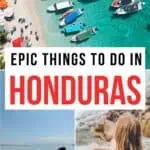We may earn income from links in this post. Please read this Disclosure for details.
While often overlooked by travellers to Central America, there are so many unique things to do in Honduras it’s well worth putting near the top of your travel wish list.
With Caribbean islands so picture-perfect they belong on postcards, dense rainforest teeming with rare birds and wildlife, plus well-preserved Maya ruins, Honduras has lots to offer.
And it provides great value compared to other popular eco-destinations such as Costa Rica and Belize.
Here’s how to do it!
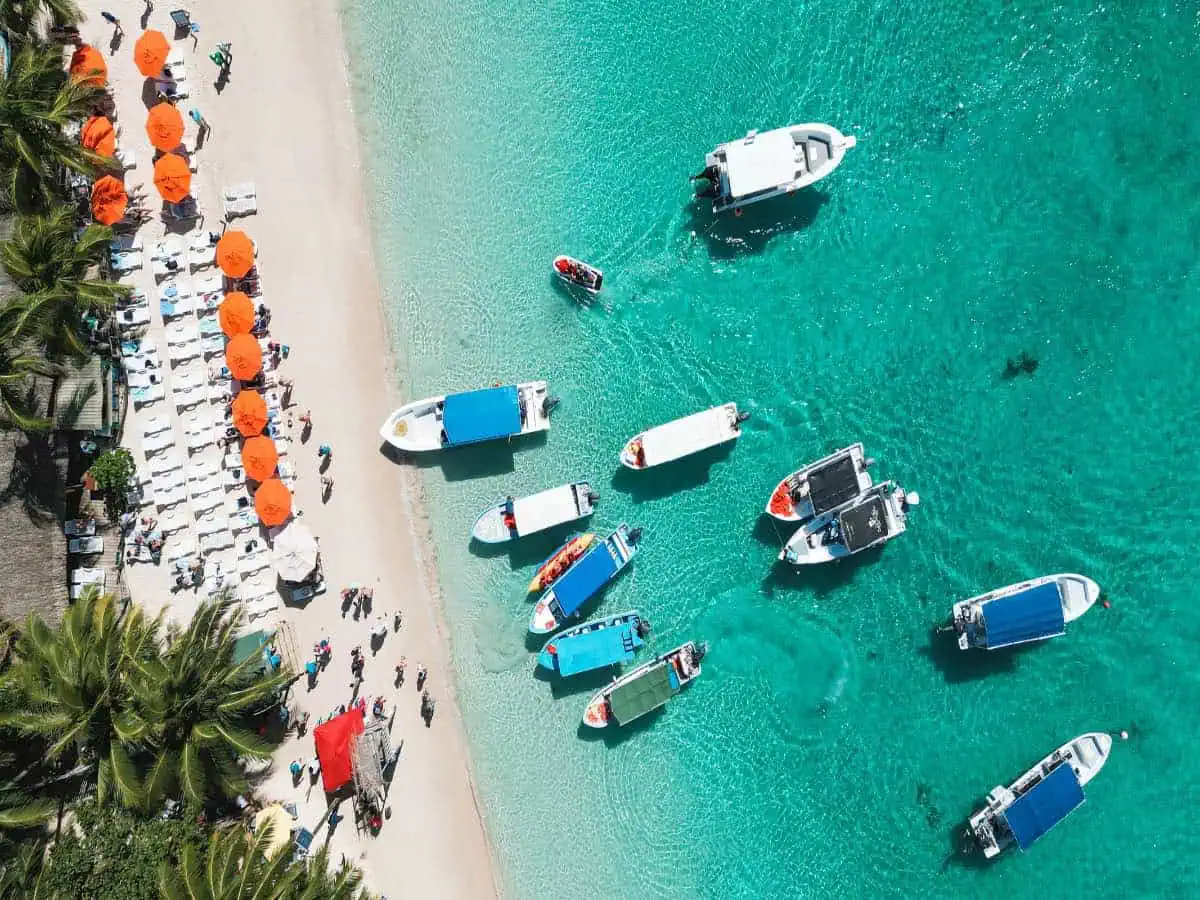
Why We’re Keen on Honduras
There’s no doubt I’m a big fan of Honduras.
Over the course of working on several micro-credit and tourism projects with NGOs in Honduras I developed a deep affection for this diverse country, its culture and its people.
While popular places like Roatán can get busy when cruise ships arrive, the country doesn’t feel touristy at all.
That’s partly due to its size. When it comes to land area, Honduras is the second largest country in Central America.
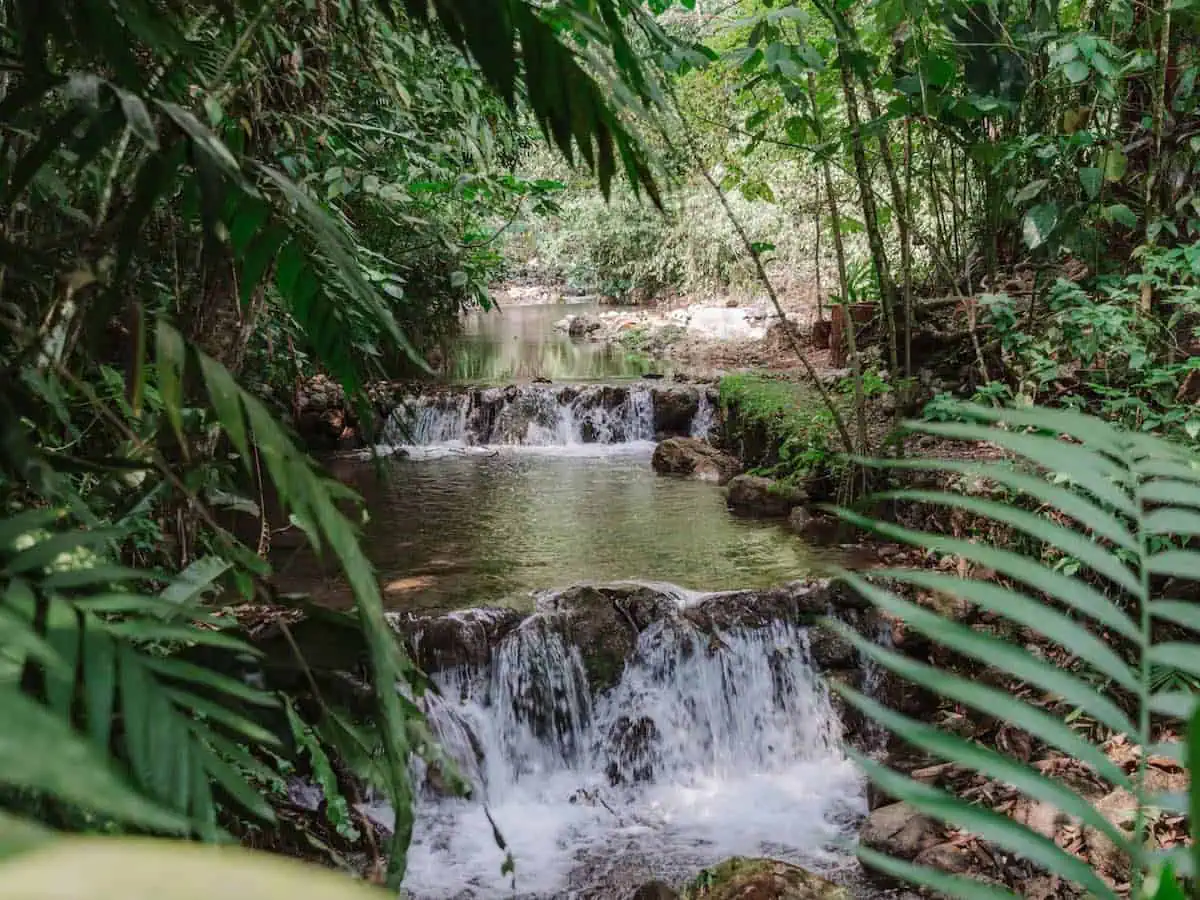
And much of it is undeveloped.
There are plenty of opportunities to explore untouched natural beauty, experience local culture and trip around historical sites without the crowds commonly found in more tourist-saturated destinations.
While it does have a history of violence and corruption (and these dangers do still exist in pockets of Honduras), the situation is improving for visitors.
With a sense of adventure, some precautionary measures and careful planning, it’s very possible to safely experience what this beautiful country has to offer.
From the underwater wonders of the Caribbean to the jungle-clad mainland, these are the very best things to do in Honduras.
1. Explore the UNESCO World Heritage Site of Copán
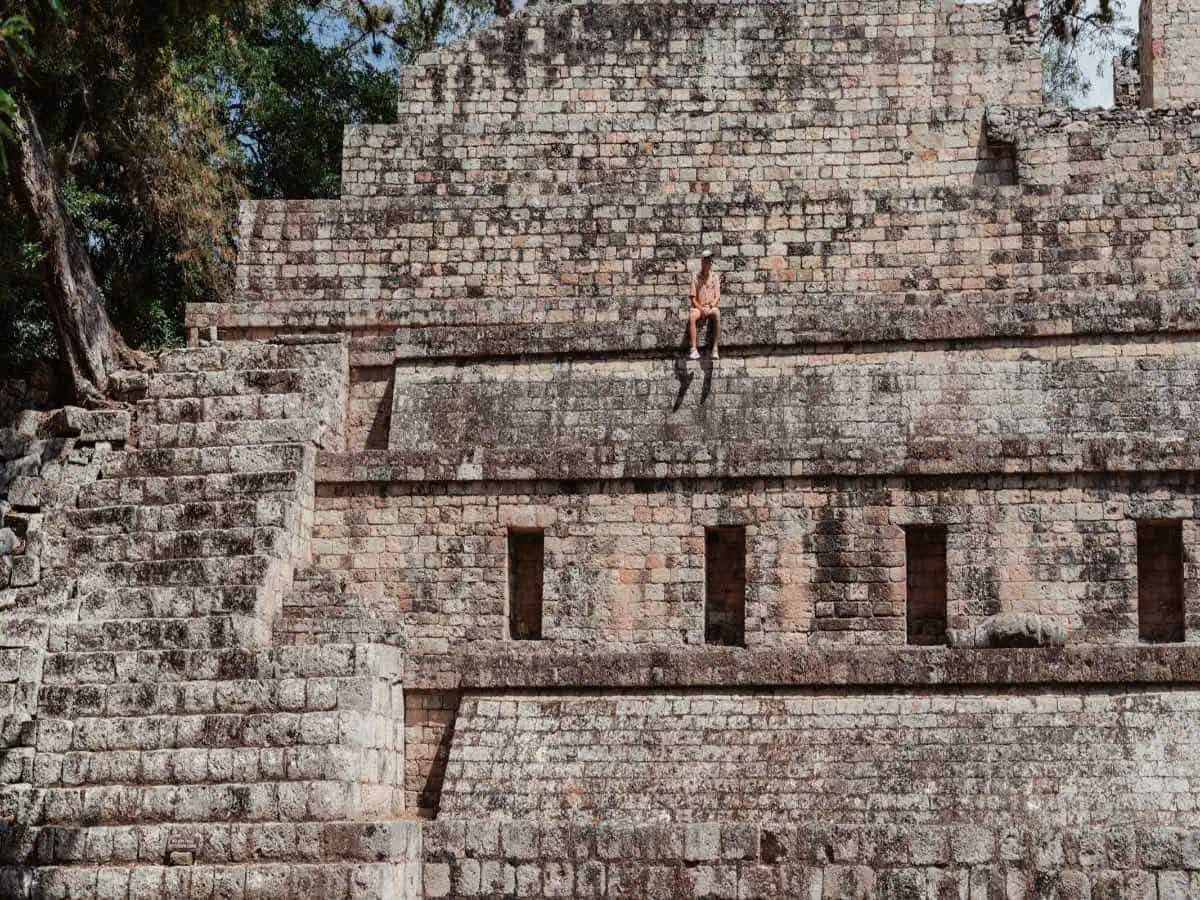
A top place to visit in Honduras is the Maya city of Copan, located in the town of Copan Ruinas near the border with Guatemala.
A UNESCO World Heritage Listed archaeological site, Copan rubs shoulders with the likes of Chichen Itza, Coba, Palenque (Mexico) and Tikal (Guatemala) as one of the great cities of the Maya world.
I first became captivated with Copán while reading the book “Incidents of Travel in Central America, Chiapas, and Yucatan” by 19th century explorer John Lloyd Stephens and artist Frederick Catherwood who documented their visit to Copán in 1839.
Catherwood’s illustrations depicted stelae and glyphs carved with motifs of gods, serpents and cosmology, and ruins of temples buried under jungle foliage.
Today many of these structures have been unearthed and preserved. Some, such as the hieroglyphic stairway recount the dynamic history of Copán’s rulers and major events.
With 2,200 hieroglyphic glyphs, it’s the longest known inscription in the Maya world.
Another remarkable sight to see in Copán is red-hued Rosalila Temple, that dates to the Late Classic Period (6th to 9th centuries AD).
In order to arrive at the archeological site early in the morning (and avoid the afternoon heat), we usually overnight in Copan Ruinas.
The Terramaya Boutique Hotel (balconies have fabulous views) and Hotel Marina Copan are your best bets for location and comfort.
2. See the National Bird of Honduras
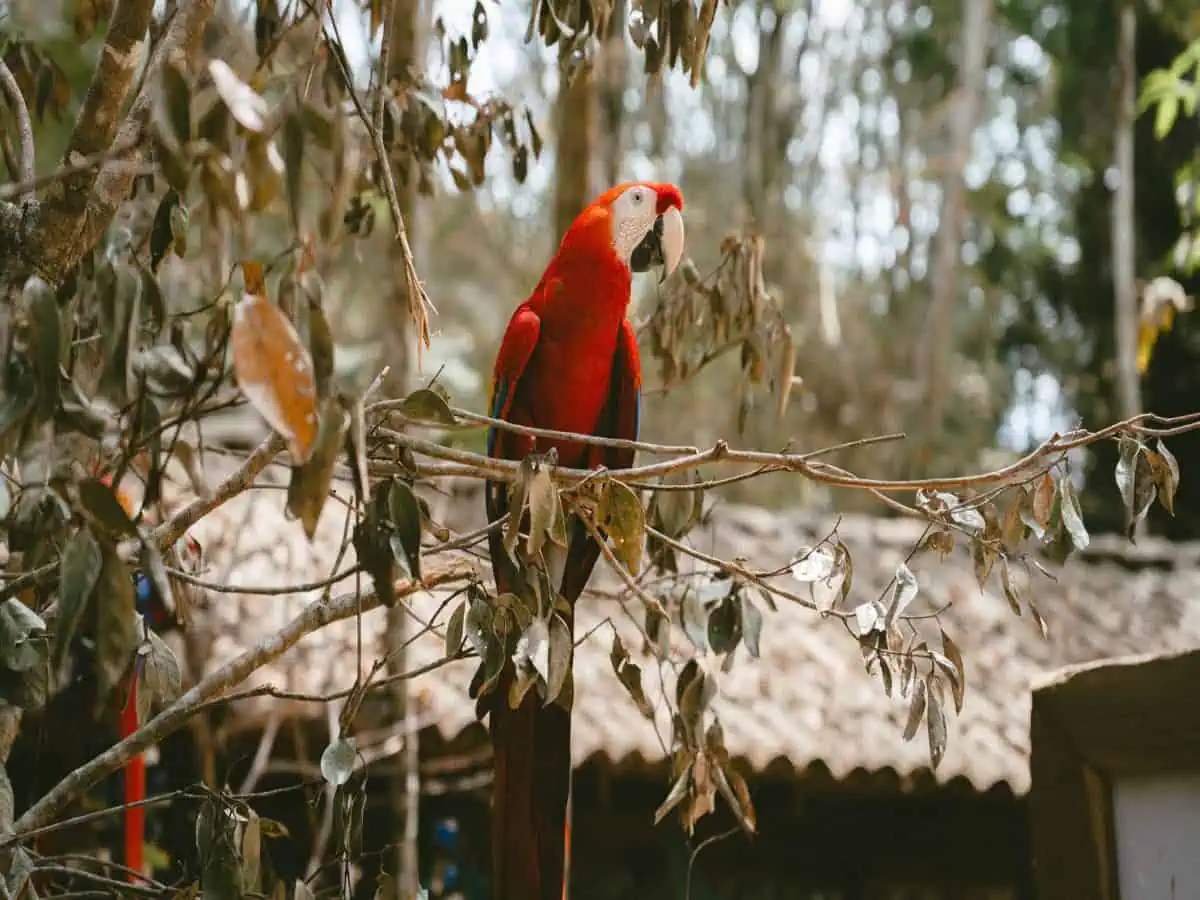
Copan Ruinas also happens to be the best place to see the scarlet macaw, the national bird of Honduras.
These majestic birds are as a loud as they are bright, with a vibrant red plumage and a noisy squawk that makes them very easy to see.
While you can see these birds throughout the country, this town lives and breathes macaws, revering the birds in the same way their Maya ancestors did.
After many years of population decline, today dozens of birds fly free throughout the archaeological site of Copan thanks to successful breeding programs.
If you don’t score a sighting at the ancient city, the Macaw Mountain Bird Sanctuary offers a guaranteed encounter with these spectacular birds.
They’re a key part of conservation projects, and you’ll see dozens of macaws at various stages of the program.
🌟 Pro Tip: Many people overnight in San Pedro Sula and take a Copan Day Trip that includes a tour of the archaeological site, the museum and the Macaw Mountain Bird Park.
3. Go Snorkeling in a Magical Underwater World
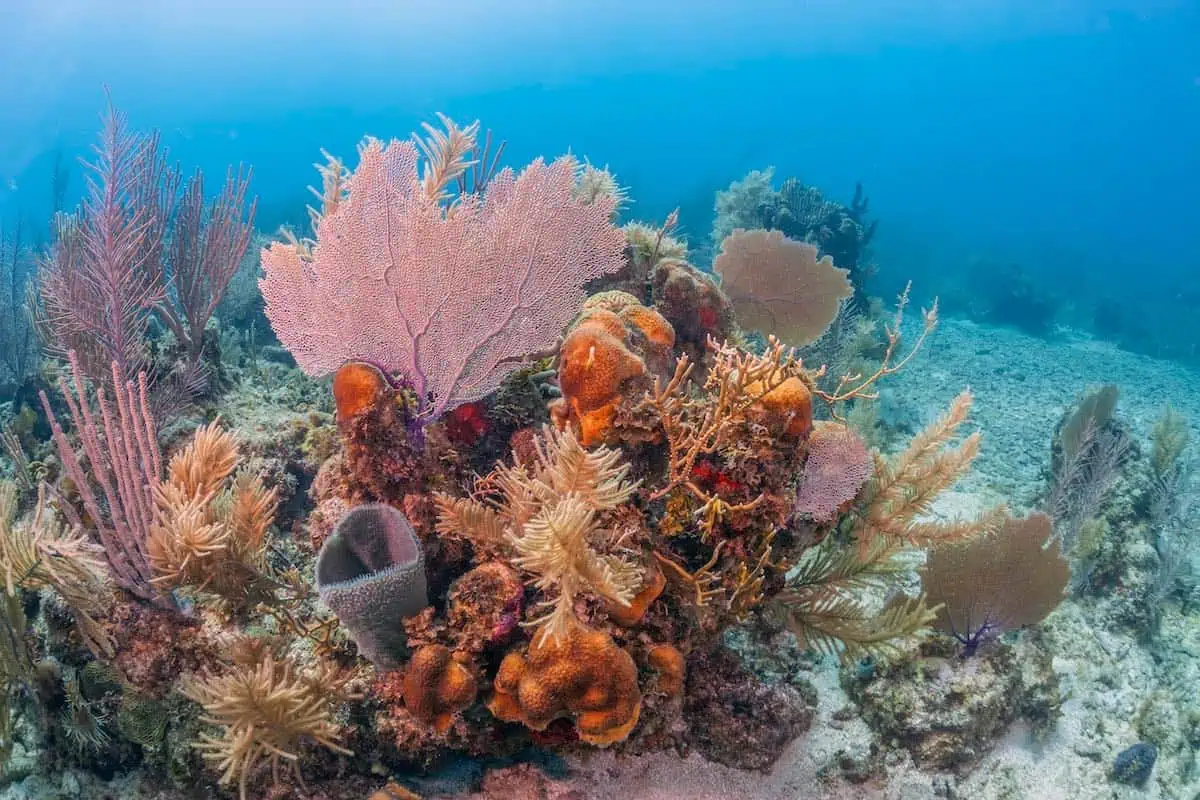
One of the most incredible things to do in Hondurasis to go snorkeling. Or even better, combine snorkeling with a wildlife encounter.
You can do both in a Combo Land and Sea Tour on Roatán, one of the Bay Islands located off the northern coast of Honduras near the Mesoamerican Barrier Reef System.
Also known as the Great Mayan Reef, it’s the second largest barrier reef in the world, stretching almost 700 miles (1000 km) along the coastline of Mexico, Belize, Guatemala and Honduras.
Although threatened by climate change and agricultural run-off, the reef system is is incredibly diverse, supporting a wide array of marine life.
According to World Wildlife Fund (WWF) the reef’s extensive network of coral provides shelter for more than 500 species of fish, five types of sea turtles and a large population of whale sharks.
Check rates and availability of a Roatan Shore Excursion: Monkeys, Sloths and Snorkeling on Viator.com
4. Get Your Scuba Diving Licence – PADI Certification
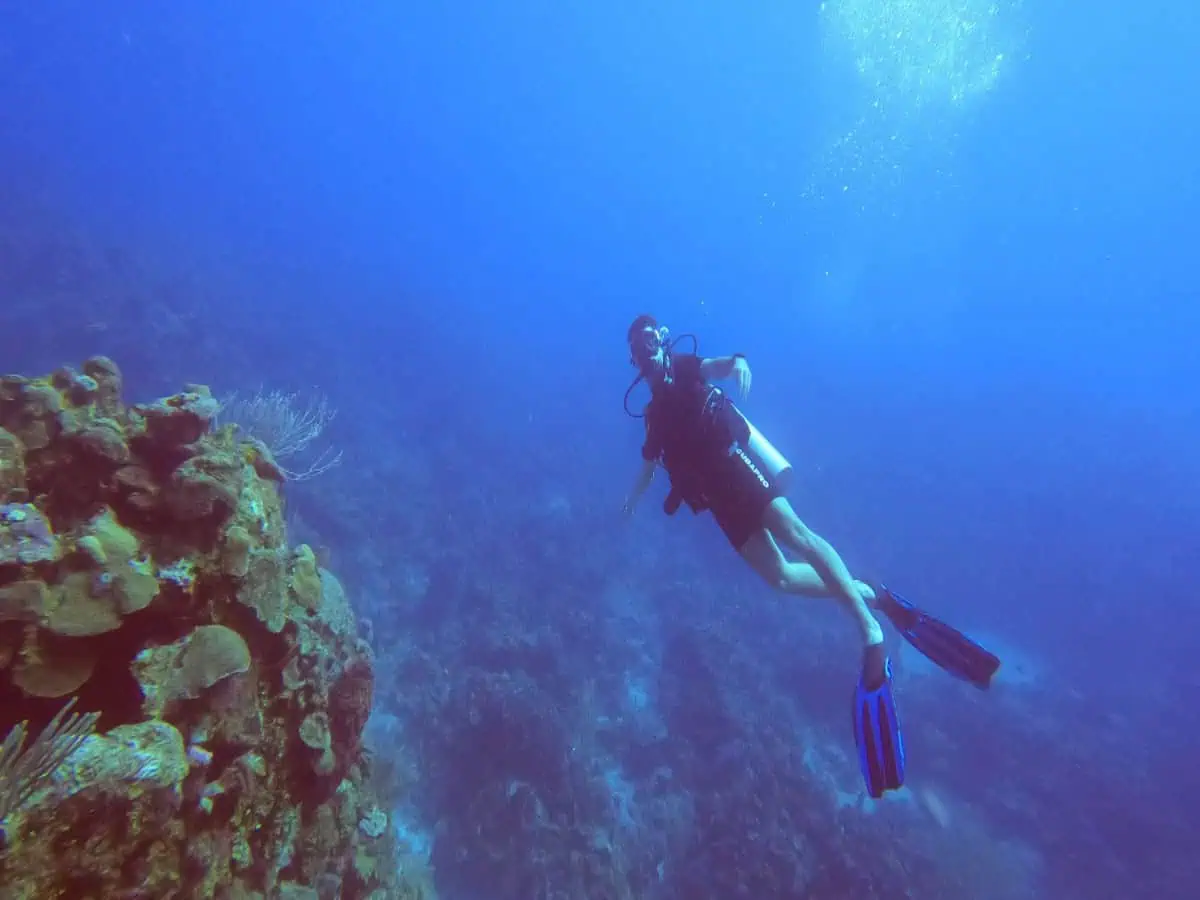
Honduras also happens to be one of the cheapest places in the world to dive and get your certification.
Roatán and Utila are the most popular spots for earning your PADI (Professional Association of Diving Instructors) Open Water certificate.
There’s some healthy competition between the two islands as to which has better reef. But it’s widely accepted that Roatán has a better condition reef, with more abundant marine life and biodiversity.
But scuba diving in Utila is better for those getting certified. Dozens of dive schools line the waterfront, offering attractive packages to budget travellers including free dorm accommodation.
It’s much more economical than Bonaire, another renowned Caribbean destination for scuba diving certification.
No matter where you choose to dive, you can expect to find yourself in a magical underwater world. With vibrant colours, towering coral walls and a maze of tunnels and swim throughs.
There’s marine life all of shapes and sizes, from countless species of fish, creeping crustaceans and bigger animals like turtles, rays and whale sharks.
If you’re not up for snorkeling or scuba diving, you can still see a variety of sea life on a glass-bottom boat tour.
These popular half-day adventures generally include a stop at the monkey and sloth wildlife sanctuary.
5. Play Castaway on a Remote Cay
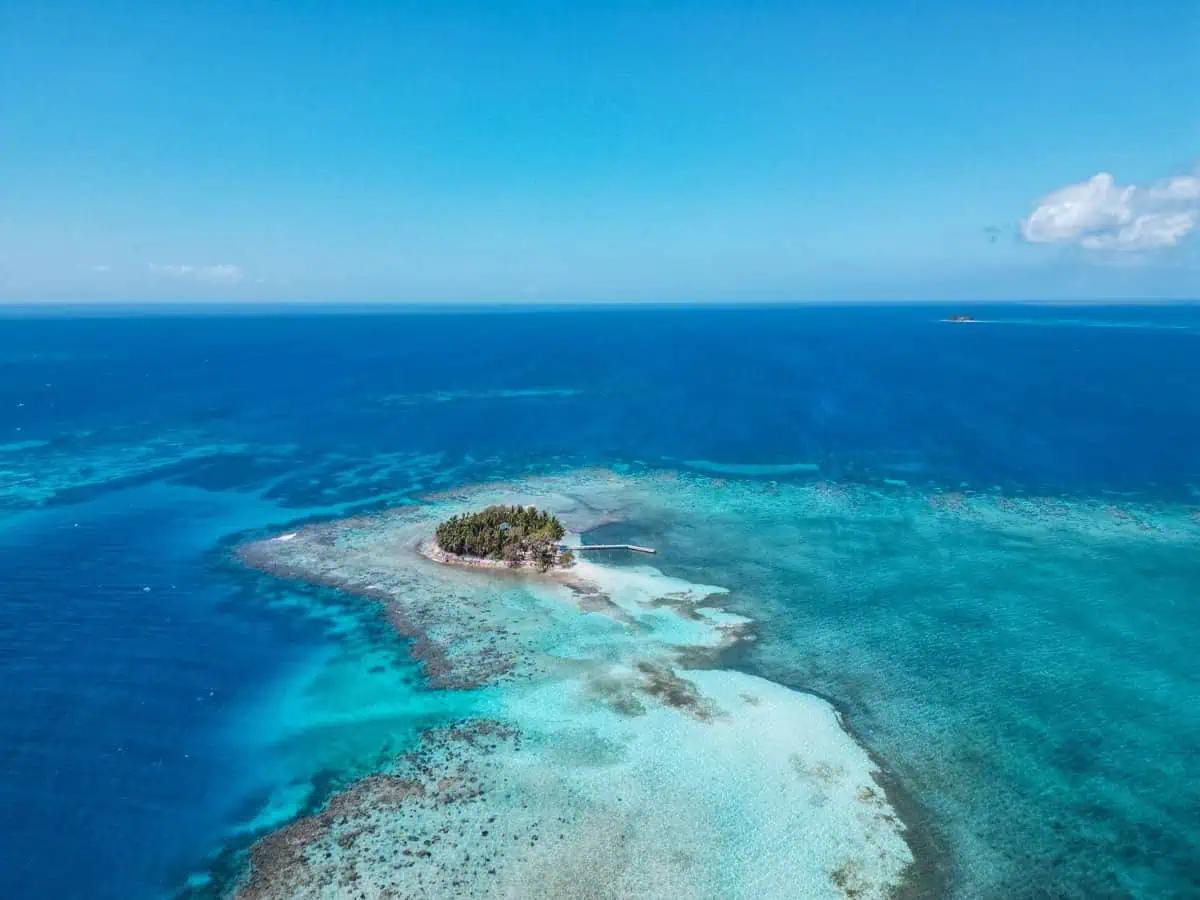
If you’re chasing a stranded-on-a-tropical-island vibe, Honduras can deliver! You won’t really be stranded, either.
The Bay Islands group is made of up of three principal islands (Roatán, Utila and Guanaja).
But this archipelago also includes dozens of tiny cays (islands formed of sand on the surface of a coral reef) where you can live out your castaway dreams.
One of the most accessible is Water Cay, a 20 minute boat ride from Utila. On this hideaway you’ll feel as if you’ve been dropped in the middle of the Caribbean.
The size of a small football field, you can wander around this sandy island in under 10 minutes, navigating through groves of palm trees and tall pines.
The reef is just a few steps offshore. There’s also a sandy lagoon that looks like nature’s best swimming pool. It’s the perfect place to float like a starfish in the crystal clear waters.
Cayos Cochinos is another option for getting away from it all. This group of islands sits between Roatán and Utila and the mainland.
It’s home to several small Garifuna communities and development is limited. You’ll enjoy empty reefs for snorkeling or diving, white sand beaches and traditional Garifuna food.
🌟 Pro Tip: Don’t miss trying tapado soup, a creamy chowder of coconut milk and freshly-caught seafood.
7. Go Kayaking on Lake Yojoa
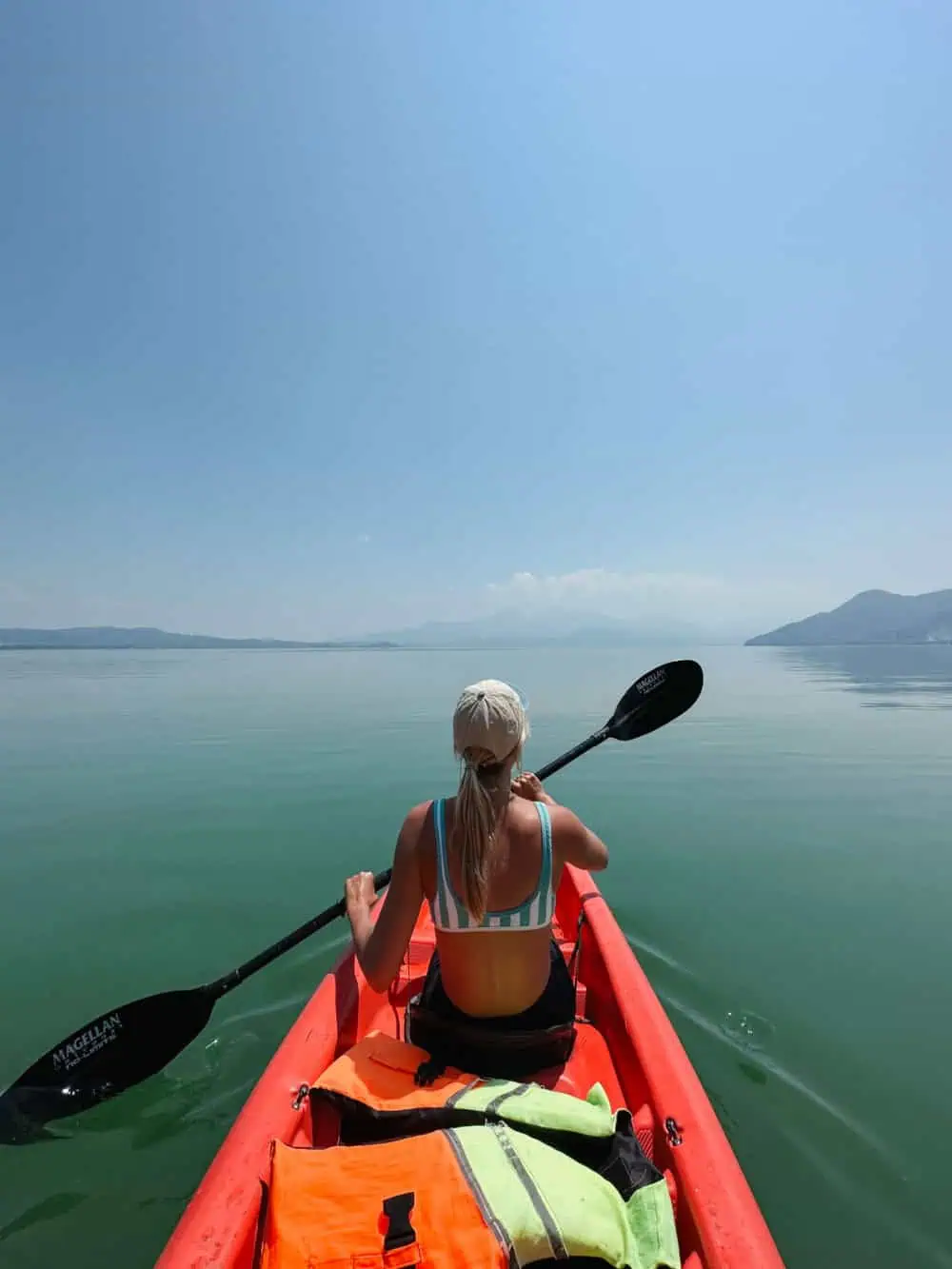
The largest lake in Honduras is a gorgeous place for a paddle. Spanning over 31 square miles (79 km²), you definitely won’t see it all.
But even a short jaunt will allow you to experience the near-360 degree mountain views. Hopefully you’ll also have sightings of at least a couple of the hundreds of species of birds living around the lake.
In addition to scarlet macaws, some of the more well-known birds you can expect to see in Honduras include great green macaws, toucans, hummingbirds, motmots, trogons, the elusive resplendent quetzal and the endemic Honduran emerald.
The small town of Los Naranjos at the northern edge of the lake is the most popular tourist hub, with the famous D&D Brewery & Lodge attracting backpackers and intrepid travellers.
Kayak rentals are readily available, with single and double options lined up along the riverbank. An all-day rental shouldn’t set you back more than the equivalent of $10 USD.
8. Go Whitewater Rafting on the Rio Cangrejal
The Cangrejal River is one of the best places in Central America to go white water rafting. The river is filled with ginormous boulders and narrow canyons to navigate, with rapids ranging from class II to V.
Although the river is only a short drive from the coastal city of La Ceiba, stay a few days in the area. Adjacent to the Pico Bonito National Park, this region offers a real eco experience.
Jungle lodges line the river, and in addition to rafting, there are opportunities for hiking, waterfalls, birdwatching and horseback riding.
Omega Tours Eco Jungle Lodge, Hotel Rio and Jungle River Lodge in La Ceiba are a few of the best lodging options. They’ll also take care of arranging your rafting tours.
9. Lounge on a Pristine Beach (or Party at a Beach Bar)
If it’s one thing Honduras does well, it’s beaches. Whether you want your stretch of sand undeveloped with jungle falling right down to the waterline, or you’d prefer a backdrop of reggae tunes and a freshly shaken cocktail, there’s a beach for you!
It’s hard to go past the famous West Bay Beach in Roatán, frequently labelled one of the best in the Caribbean.
Its beachside hangouts are on par with our favourite beach bars in Curaçao, Anguilla and Aruba.
Although busy, the powdery white sand, electric blue waters and fringe of palm trees will make even the most reclusive of travellers happy, despite the crowds.
Half Moon Bay Beach and Camp Bay Beach offer quieter alternatives on Roatán. Neighbouring Guanaja takes quiet to a new level, with very few tourists to share the gorgeous Bayman Bay Beach or Soldado Beach.
One of my favourite beach destinations in Honduras is Tela. Located on the mainland, it has some gorgeous stretches of sand and a lively Garifuna community.
Beyond its beaches, Tela is surrounded by protected natural areas, including the Lancetilla Botanical Garden, the second largest tropical botanical garden in the world.
At the Jeanette Kawas National Park, you can explore mangrove forests, hike scenic trails, and spot exotic wildlife.
10. Marvel at Pulhapanzak Waterfall
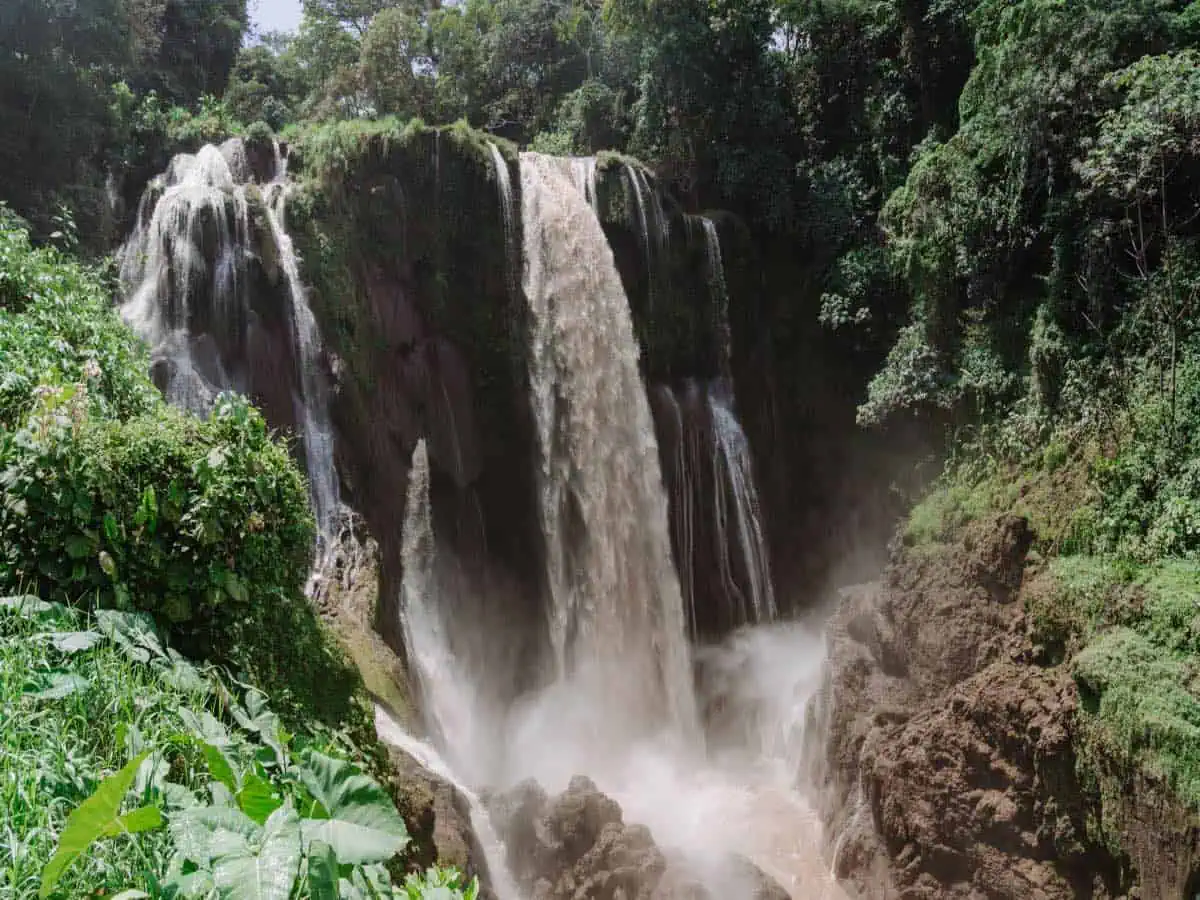
Falling over 141 feet (43 m), Cataratas Pulhapanzak is the biggest waterfall in Honduras.
Affectionately called ‘Pulha’ by the locals, this impressive display of water pounding down a rocky cliff is spectacular.
Swimming is strictly prohibited due to the force of the falls. But if just looking isn’t enough, you can step up the adrenaline a notch!
The ‘behind the waterfall’ tour would not pass any OHS tests in more developed countries, but it’s a thrilling adventure.
Together with a guide, through a combination of swimming, jumping and crabwalking with your eyes closed, you’ll venture behind these pounding waterfalls!
You’ll be soaking wet, blinded and at times gasping for air, but completely blown away by the sheer force of the water.
For something a little lighter on the adrenaline, you can zipline across the top of the falls.
Cataratas Pulhapanzak are best visited on a tour from San Pedro Sula.
Or as part of a stay in the Lake Yojoa region. The falls are about half an hour away from the town of Los Naranjos Ecological and Archeological Park (Google Map).
There, a top spot to stay is D&D Brewery & Lodge, known for its micro-brewery and tap room producing a half dozen varieties of craft beer.
11. Venture deep into the Rio Platano Biosphere Reserve
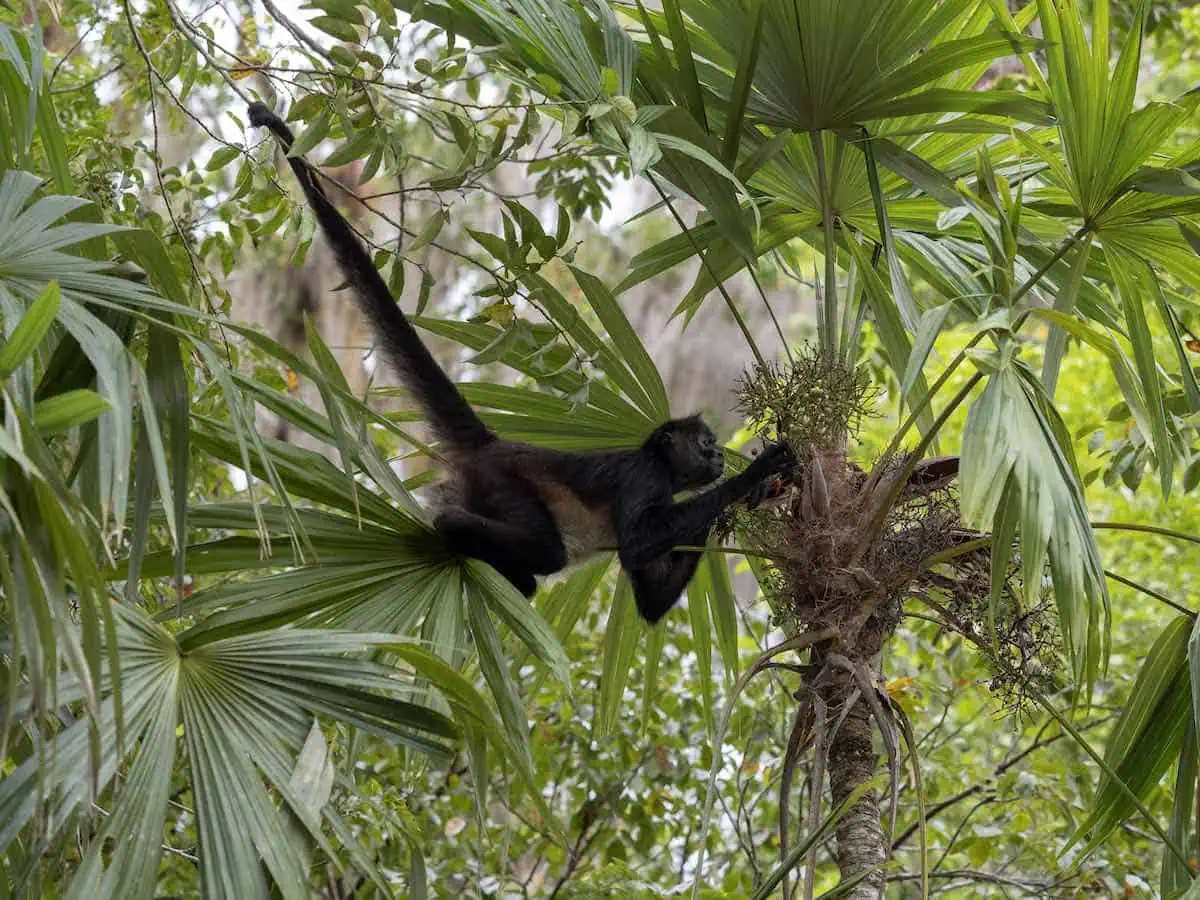
Wildlife fanatics, adventure junkies and anyone with a desire to get seriously off the beaten track needs to visit the Reserva de la Biosfera de Río Plátano (Google Map).
Part of the raw and wild La Mosquitia region. It occupies the entire northwestern corner of the country and is one of the last remaining tracts of virgin tropical rainforest in Central America.
Small indigenous communities have maintained their traditional ways of life inside the bounds of the reserve, with incredibly limited access and few modern-day amenities.
The biodiversity is astounding. The reserve is home to rare and endangered species such as tapirs, jaguars, spider monkeys and giant anteaters, found in few other places throughout the region.
Over 400 species of birds, 100 species of amphibians and reptiles and more than 700 varieties of plants round out the reserve’s impressive resume.
Access is strictly with certified guides and is a multi-day adventure involving lots of trekking and transport via dug out canoes or tiny planes.
12. Eat Baleadas and Other Traditional Honduran Food
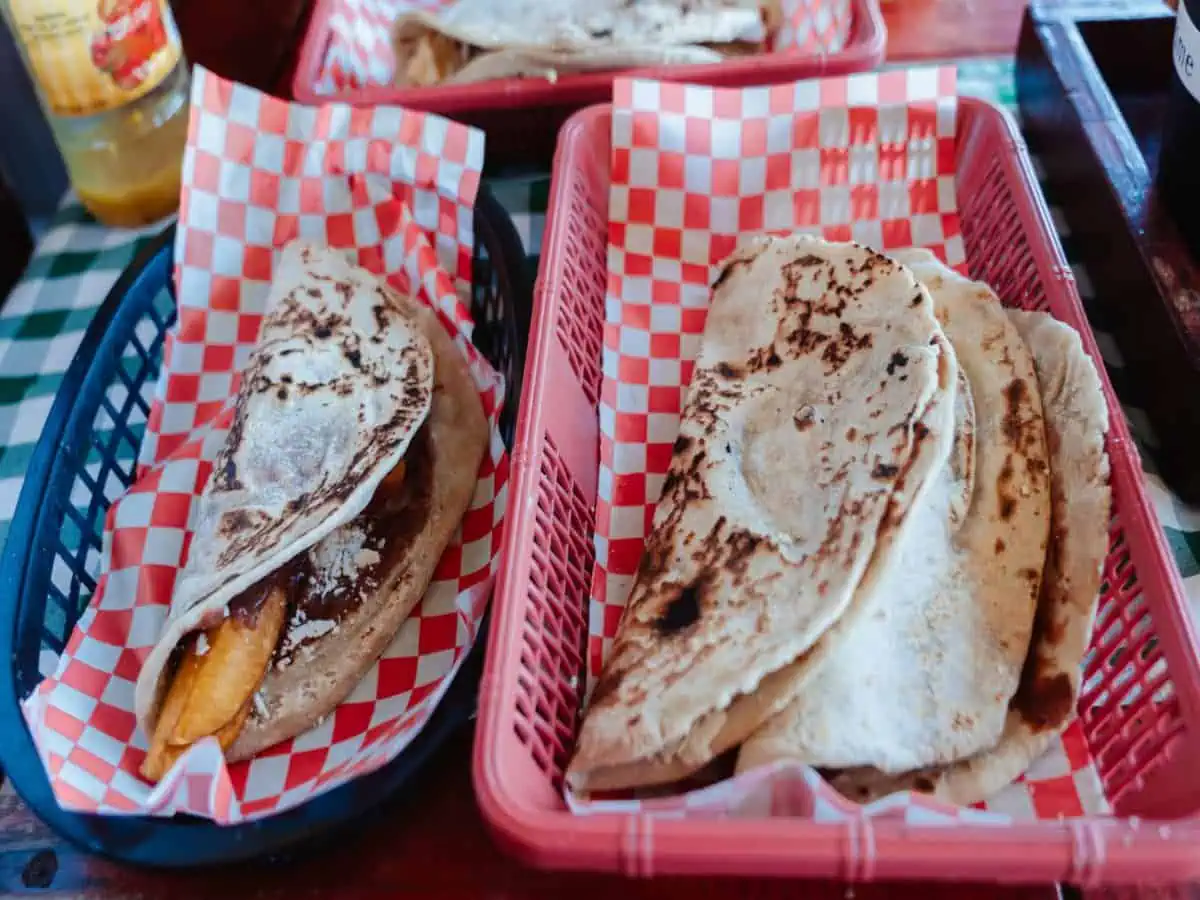
Honduran cuisine is influenced by Indigenous, African, and Spanish cuisines, among others.
The unofficial national dish of Honduras is the humble baleada, and no trip is complete without consuming at least one per day.
Somewhat similar to the tlayudas of Oaxaca, a baleada is a large flour tortilla folded in half, topped with refried beans, crema and crumbled white cheese plus your choice of fillings.
You’ll see egg and avocado at breakfast or meat, seafood or vegetables for lunch and dinner.
Cheap, filling, tasty and readily available, baleadas are a budget traveller’s best friend in Honduras. Standard options are generally priced under $2 USD.
Even on the pricier Bay Islands, baleadas are still an affordable feast.
🌟 Insider Tip: Calelu’s and Yahongreh are top choices in Roatán, while in Utila there is an ongoing baleada rivalry between neighbouring restaurants, La Casita and Mama Rosa.
Other must-try Honduran dishes include tapado seafood soup, yuca con chicharrón (somewhat similar to Guatemalan chojin), tamales, sopa de caracol (conch) and enchiladas, rolled tortillas filled with a picadillo (shredded chicken, potatoes and carrots) topped with salsa and shredded cabbage.
For lunch, you’ll often see plato tipico, a traditional daily special featuring rice and beans (usually red beans), fried plantains, and grilled beef, chicken or pork.
Enjoy your plato tipico with a chilled Salva Vida, a lager that’s the national beer of Honduras. Or, pinol, atole de elote (also a popular drink in Guatemala and Mexico),horchata, licuados, batidos and more.
13. Tour a Coffee Plantation
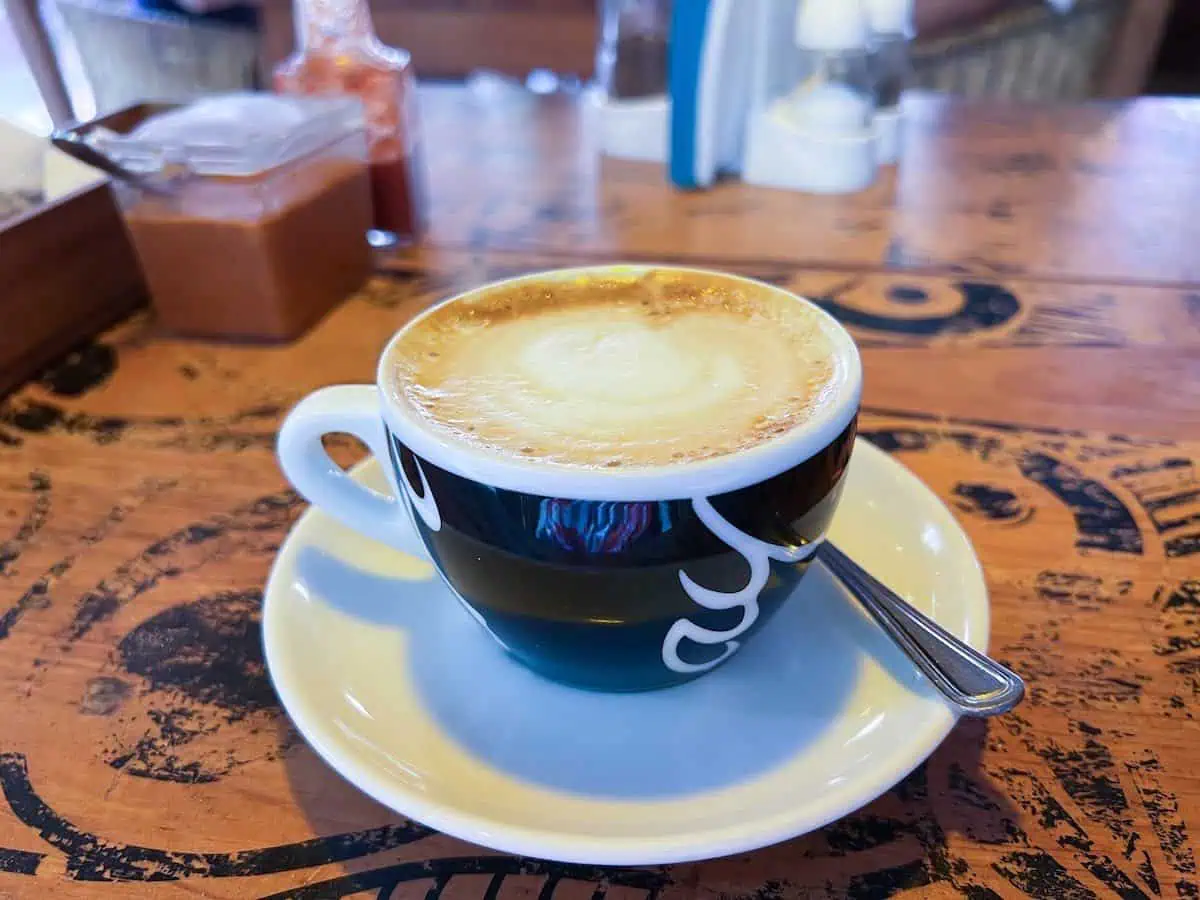
As the largest producer of coffee in Central America, coffee is big business in Honduras.
In addition to frequenting the excellent cafes found all over the country (even in the unlikeliest rural towns), a great thing to do in Honduras is a tour of a coffee plantation.
There are dozens of farms all over the country offering an inside look at the process of making coffee. It’s enlightening to learn what goes into one cup of coffee, that most of us would consume multiple times per day.
From growing the plants, harvesting the cherries, separating, processing and drying the beans, to roasting and grinding, it’s a lengthy process that dedicated farmers perform tirelessly.
The family owned and operated farms are proud that the industry hasn’t been dominated by big coffee corporations.
Joining a tour is a great way to engage with the local community, and learn more not only about coffee, but the way of life in Honduras, their culture and society.
14. Take a Hike in a Rainforest
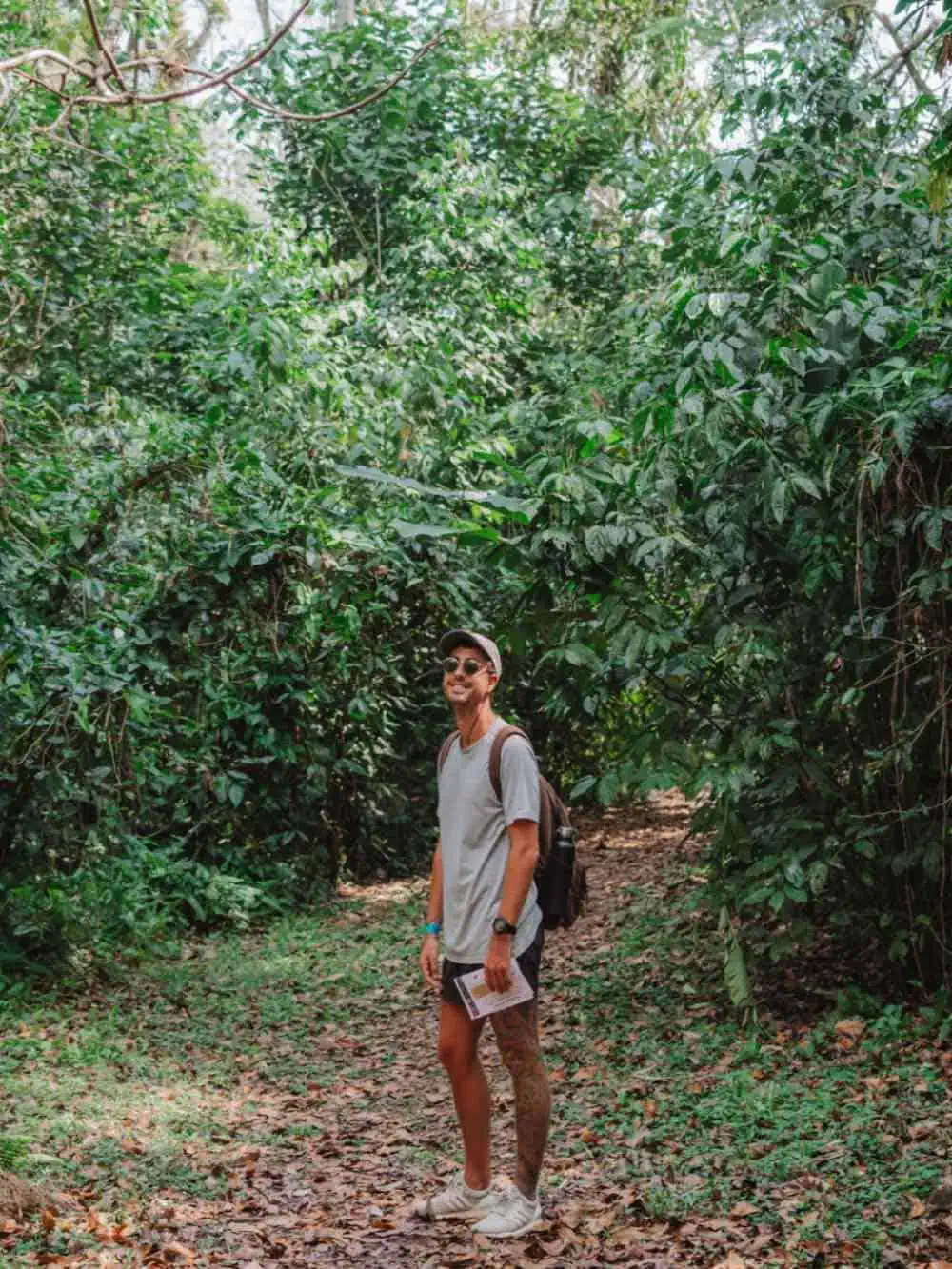
Whether you’re looking for a challenging mountain to summit, a simple stroll along a jungle-lined path or a trek through the cloud forest, Honduras has miles of trails to explore.
The Pico Bonito National Park is an excellent place for a hike in dense tropical forest. The trail to El Bejuco waterfall is a particularly popular, if not slightly challenging option.
If you want to summit a peak, the highest in the country is Cerro Las Minas in the Celaque National Park.
Multi-day, guided treks depart from the colonial town of Gracias. The Santa Barbara Mountain is another tough summit through foggy cloud forest.
The Lake Yojoa region has some pleasant walks through lush rainforest on private nature reserves like Bioparque Paradise, and in national parks like Cerro Azul Meambar.
The La Tigra National Park, just outside the capital city of Tegucigalpa is a well-developed and maintained park.
It’s got lots of trail options, used mainly by locals seeking some outdoors time and an escape from the city.
15. Soak in Natural Hot Springs
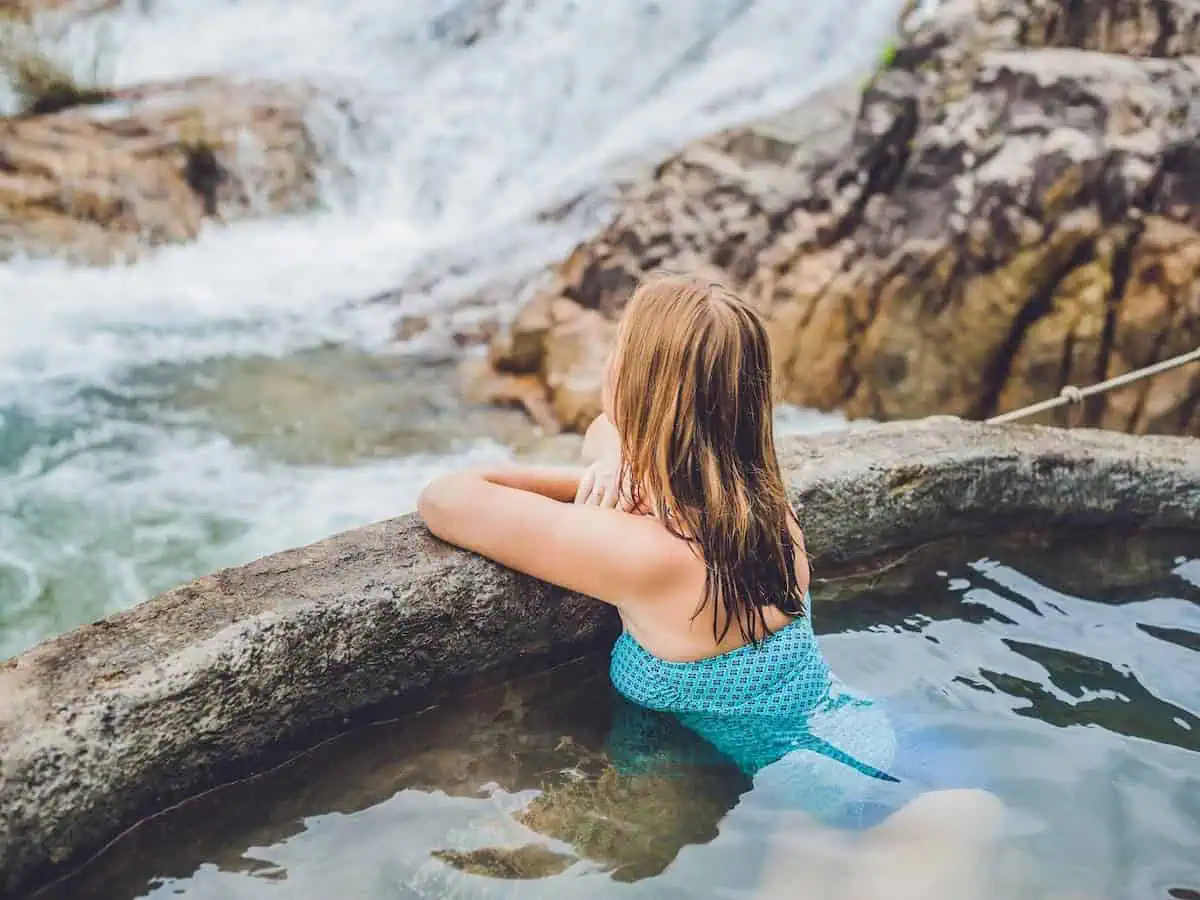
While Honduras may not have the same volcanic reputation as its neighbours Guatemala, El Salvador and Costa Rica, there are still some fantastic thermal waters to soak in.
Don’t expect anything fancy, basking in a hot spring is a nice way to spend a relaxing day after all your active pursuits around the country.
In the hills outside of Copán Ruinas, the Luna Jaguar Spa (Google Map) is a popular option for travellers after spending the day wandering around the ancient Maya city.
In the neighbouring Lempira department, the town of Gracias has a handful of rustic aguas termales (hot springs).
They’re just what the doctor ordered for hikers who have just submitted nearby Cerro Las Minas, the highest peak in the country.
16. Wander Through Charming Towns
Like most countries in Central America, Honduras was once occupied by the Spanish, leaving an architectural legacy of grand cathedrals, palaces and colonial buildings.
If you can drag yourself away from the beaches, Caribbean Sea and the forest trails, spending a few days exploring one of its charming towns is a great thing to do in Honduras.
Gracias is one example. Once the capital of the Spanish colony in Central America, it has several museums, boutique hotels and cafes.
It’s also the closest town to La Campa, a pine-scented village that’s home to the pilgrimage site of San Mathias church, Central America’s longest zipline and several Lenca pottery shops.
Another pretty place in Honduras is Comayagua. While more city than town, the former capital of Honduras feels as if you’ve stepped back in time. Its spectacular cathedral houses one of the oldest clocks in the Americas.
Plus. there are several museums and a lively central plaza that offers an authentic glimpse into local life in Honduras.
With the recent opening of the Palmerola International Airport, replacing the airport in Tegucigalpa, Comayagua will become a stop on more travellers’ itineraries.
17. Experience Big City Life in Tegucigalpa
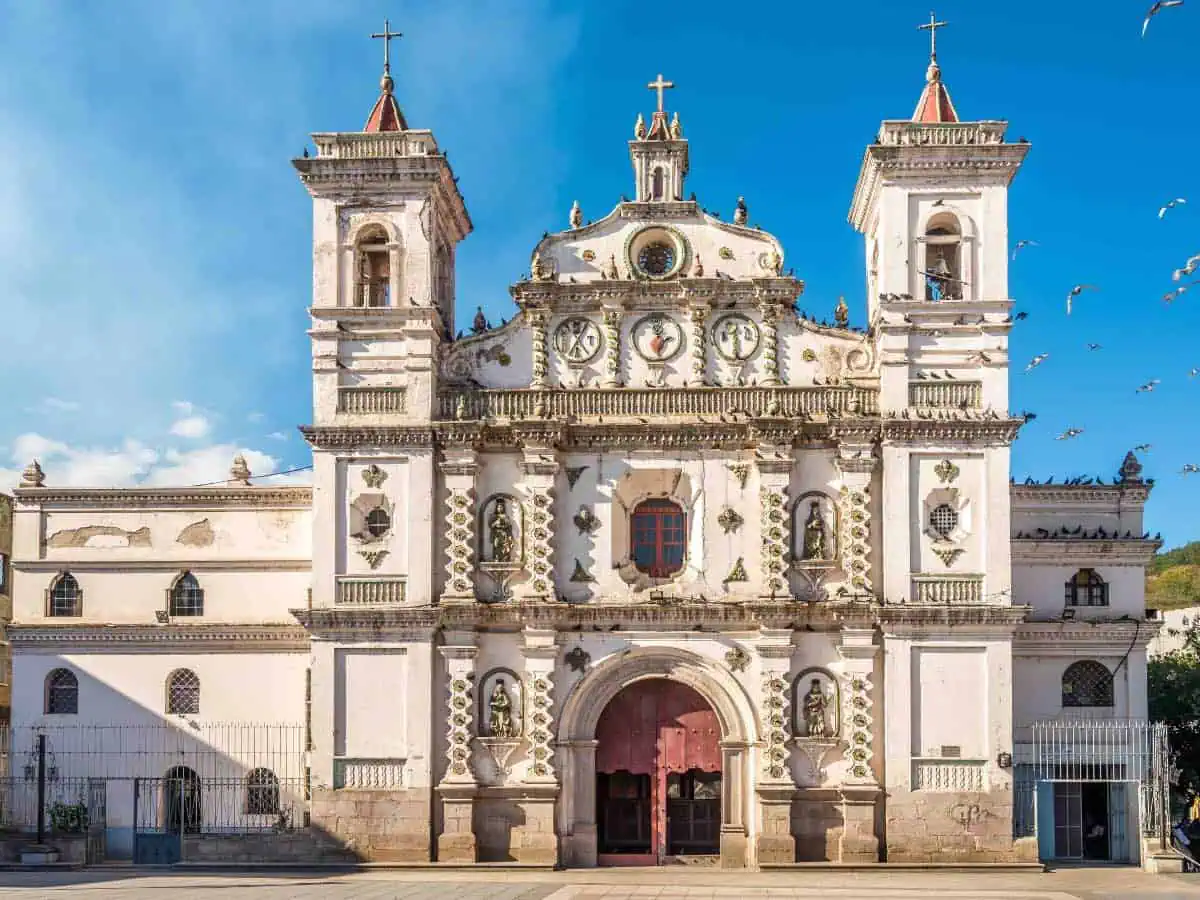
While many people skip over the capital city of Tegucigalpa, it is well worth spending a few days here to soak up some history and culture.
I spent more than a month in Tegucigalpa and while it’s best to confine your explorations to daytime (and avoid certain neighbourhoods completely) for safety reasons, there are several attractions you don’t want to miss.
The city’s religious landmarks include the Basilica de Suyapa, a revered Catholic church dedicated to the Virgin of Suyapa, the baroque Iglesia de Los Dolores and the Cathedral of Saint Michael the Archangel.
For a photo-op El Picacho hill offers panoramic views and a towering statue of Christ. Family travellers won’t want to miss exploring the interactive exhibits at Chiminike, a children’s museum.
The mountain village of Valle de Ángeles with its cobblestone streets and handicraft shops is another popular place to spend a day with the family.
Honduras Travel Planning Information
Getting to Honduras
If you’re flying in, there are international airports in Roatán, San Pedro Sula and Comayagua. Honduras also has land borders with Guatemala, El Salvador and Nicaragua.
Getting Around Honduras
There are a variety of transport options depending on your itinerary and budget. Getting to and from the Bay Islands is primarily by ferry or domestic flight.
On the mainland, coach buses, “chicken buses” and colectivos (shared vans) are the primary public transport options. Car rental and private transfers are also available.
We rent our cars on Discovercars.com. It’s an online car rental booking site that compares rates from several companies to find the best deal.
Currency
Honduras uses the Honduran Lempira (HNL or L). The current exchange rate is approximately 25 HNL = 1 USD.
US dollars are accepted in touristy areas like the Bay Islands. The rate is generally more favourable if you pay in local currency.
ATMs
Credit cards are accepted in larger cities and touristy areas. But cash is king in Honduras and you should always carry sufficient amounts.
ATMs are widely available throughout the country, although if you’re going somewhere remote, stock up on cash in advance.
It’s safest to stick with ATMs affiliated with banks to reduce the risk of skimming and other scams.
Save to Pinterest!
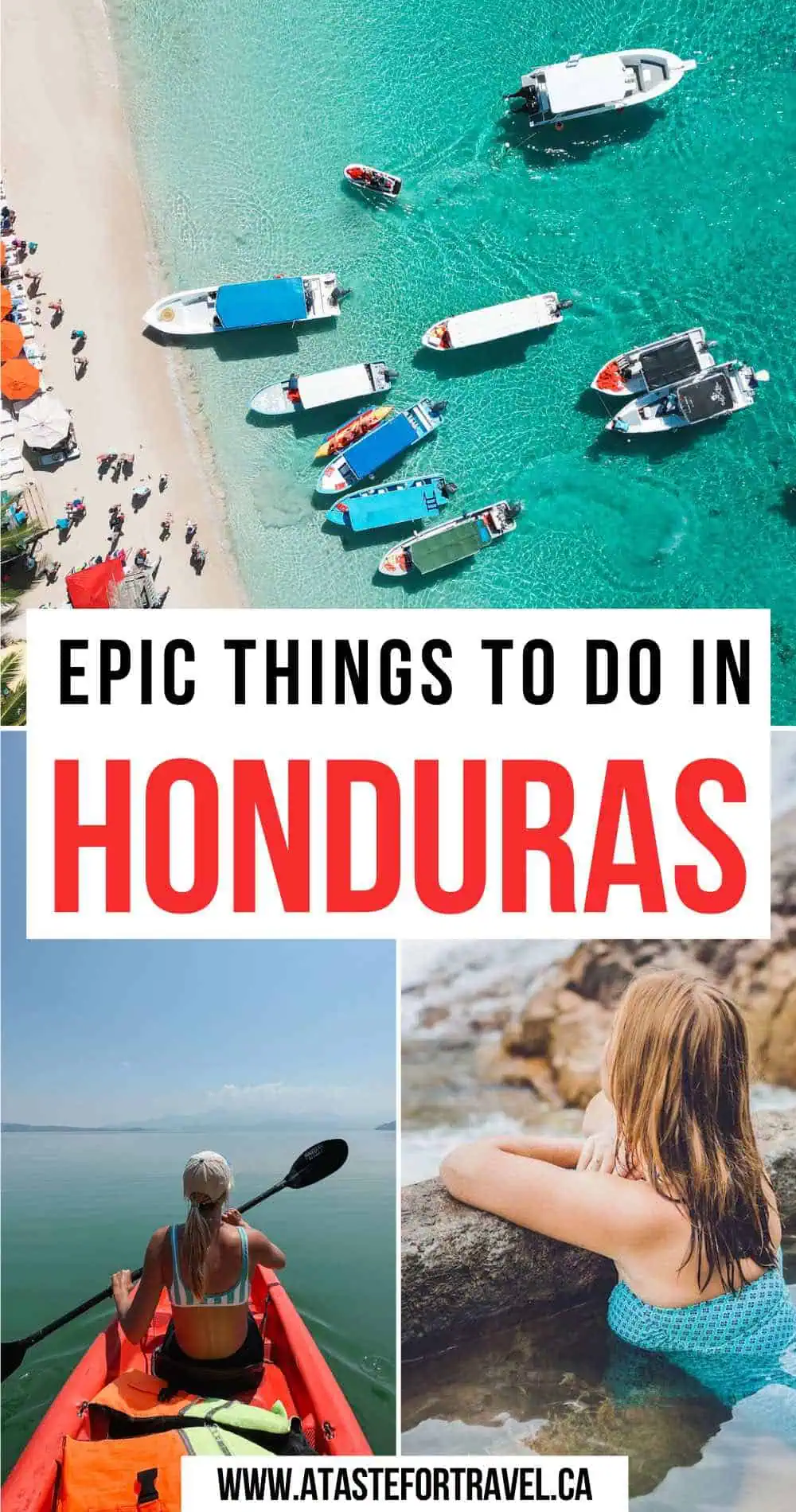
More Central America Travel Inspiration

Dividing her time between Canada, Guatemala and Mexico (or the nearest tropical beach), Michele Peterson is the founder of A Taste for Travel. Her award-winning travel and food writing has appeared in Lonely Planet’s cookbook Mexico: From the Source, National Geographic Traveler, Fodor’s and 100+ other publications.
Read more about Michele Peterson.


